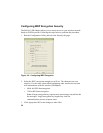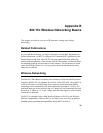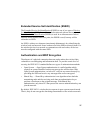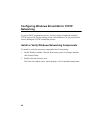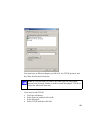36
Wireless Network Configuration
The 802.11b standard offers two methods for configuring a wireless network —
ad hoc and infrastructure.
Ad Hoc Mode (Peer-to-Peer Workgroup)
In an ad hoc network, computers are brought together as needed; thus, there is no
structure or fixed point in the network — each node can generally communicate
with any other node. There is no access point involved in this configuration. This
mode enables you to quickly set up a small wireless workgroup and allows
workgroup members to exchange data or share printers as supported by Microsoft
Networking in the various Windows operating systems. Some vendors also refer
to ad hoc networking as peer-to-peer group networking.
In this configuration, network packets are directly sent and received by the
intended transmitting and receiving stations. As long as the stations are within
range of one another, this is the easiest and least expensive way to set up a
wireless network.
Infrastructure Mode
With a wireless Access Point, you can operate the wireless LAN in the
infrastructure mode. This mode provides wireless connectivity to multiple
wireless network devices within a fixed range or area of coverage, interacting
with wireless nodes via an antenna.
In the infrastructure mode, the wireless access point converts airwave data into
wired Ethernet data, acting as a bridge between the wired LAN and wireless
clients. Connecting multiple access points via a wired Ethernet backbone can
further extend the wireless network coverage. As a mobile computing device
moves out of the range of one access point, it moves into the range of another. As
a result, wireless clients can freely roam from one access point domain to another
and still maintain seamless network connection.







